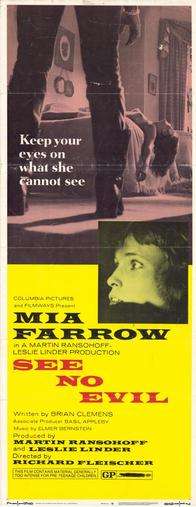See No Evil (1971 film)
| See No Evil | |
|---|---|
 | |
| Directed by | Richard Fleischer |
| Produced by | Martin Ransohoff |
| Written by | Brian Clemens |
| Starring |
Mia Farrow Dorothy Alison Robin Bailey |
| Music by | Elmer Bernstein |
| Cinematography | Gerry Fisher |
| Edited by | Thelma Connell |
Production company | |
| Distributed by | Columbia Pictures |
Release dates | 2 September 1971 |
Running time | 89 minutes |
| Country | United Kingdom |
| Language | English |
See No Evil, also known as Blind Terror, is a 1971 British thriller film directed by Richard Fleischer and starring Mia Farrow as a recently blinded woman terrorized by a psychopath.
Plot
After being blinded in a horse riding accident, Sarah (Mia Farrow) visits her uncle's home. Out on a date with her boyfriend Steve (Norman Eshley), she escapes the fate of her relatives (Dorothy Alison, Robin Bailey, and Diane Grayson), who are murdered at their home by a psychotic killer. Sarah returns from her date and spends the night in the house, unaware that three of her family members' corpses are strewn about the house.
She eventually discovers the bodies, as well as a bracelet containing the engraved name of the killer. The killer returns, searching for the lost bracelet and discovers Sarah, who manages to flee on horseback. Sarah encounters a family of gypsies and shows them the bracelet with the name "Jacko" inscribed. One of the gypsies concludes that his brother Jack must be responsible. In an effort to save Jack, the brother pretends to take Sarah to the police but, instead, locks her in a secluded shed.
Sarah eventually escapes from the shed and reunites with Steve. Steve and his stable boys leave Sarah at his house and begin a search for the killer. They come across the two gypsy brothers and are about to kill them, when Jack reveals that he wears a bracelet with the name "Jack", and not "Jacko," inscribed. Steve, upon learning that the real killer's name is "Jacko", doubles back to his house, where it is revealed that one of the groomsmen, Jacko (Paul Nicholas), had been left behind to tend to Sarah. Back at the house, Jacko attempts to drown Sarah in a bathtub, but Steve returns just in time to rescue her.
Cast
- Mia Farrow as Sarah
- Dorothy Alison as Betty Rexton
- Robin Bailey as George Rexton
- Diane Grayson as Sandy Rexton
- Brian Rawlinson as Baxter
- Norman Eshley as Steve Reding
- Paul Nicholas as Jacko
Production
Interviewed in 1997, writer Brian Clemens recalled that he wrote the script 'on spec' and Columbia Pictures told him: "'Well, if Mia Farrow plays the lead, we'll buy it,' and she read it and liked it, and so they bought it and we shot it.'"[1] Filming took place in Berkshire, England, with a mainly British cast and crew.[2]
Reception and criticism
Its theatrical release in the United States was 'a box office disappointment' and reviews were 'generally mixed'.[2] The New York Times wrote:
"See No Evil has its share of thrills. Cheap thrills, to be sure, but thrills none the less - and everything in the rest of Richard Fleischer's new movie... encourages us to value small favors. Attempting on the one hand to mean something and on the other hand trying to crank up the terror, Fleischer keeps suggesting confrontations between the rich and the poor, the old and the young, families with daughters to protect and men with warped desires. For all the potency of a camera movement, it can never have exactly the power of a conceptual image, and therefore "See No Evil" is better with its mindless terror than with its witless meaning. And although everything becomes far too much long before it is over, the movie is generally at it most ridiculous precisely where it hopes to make sense."[3]
'For sheer suspense', wrote The Palm Beach Post, it 'may well be without peer', but, while praising the performance of Mia Farrow, considered the 'fiendish gamut' of injury her character is subjected to could 'only be called sadism'.[4]
Screenwriter Brian Clemens was nominated for an Edgar Allan Poe Award.
Later reviewers have described the film as a 'creepy, atmospheric thriller', in the style of Terence Young's 1967 film Wait Until Dark,[5] while critic John Derry highlights the way Mia Farrow is presented 'from the first moment' as 'the obvious victim'.[6]
References
- ↑ Wheeler W. Dixon (2000-02-28). The Second Century of Cinema: The Past and Future of the Moving Image. SUNY Press. p. 126. ISBN 978-0-7914-4516-7.
- 1 2 Stafford, Jeff. "See No Evil (1971)". Turner Classic Movies. Retrieved 2013-11-04.
- ↑ Greenspun, Roger (1971-09-11). "'Mindless terror, witless meaning': See No Evil 'has thrills' with Mia Farrow, and likable cast". Calgary Herald. Retrieved 2013-11-04.
Reprint of The New York Times review
- ↑ Benninger, Jerry (1971-10-11). "See No Evil: Sheer Suspense". Palm Beach Post. Retrieved 2013-11-04.
- ↑ Yoram Allon; Del Cullen; Hannah Patterson (2002). Contemporary North American Film Directors: A Wallflower Critical Guide. Wallflower Press. p. 173. ISBN 978-1-903364-52-9.
- ↑ Charles Derry (1988). The Suspense Thriller: Films in the Shadow of Alfred Hitchcock. McFarland. p. 35. ISBN 978-0-7864-6240-7.